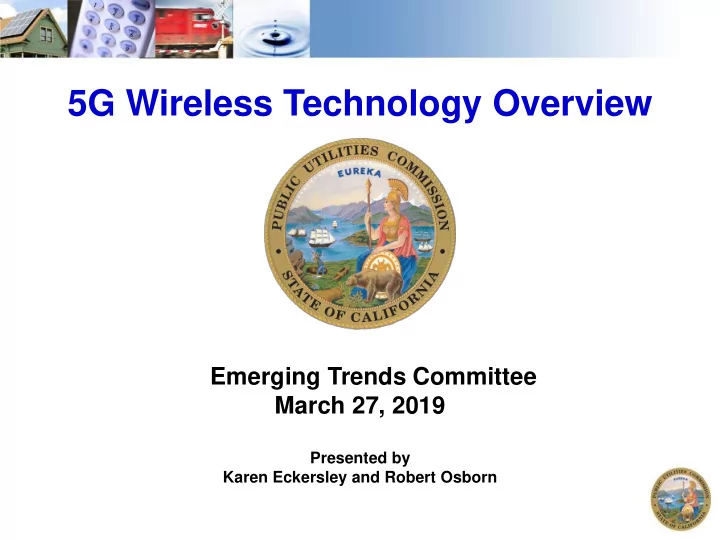

5G Wireless Technology Overview Emerging Trends Committee March 27, 2019 Presented by Karen Eckersley and Robert Osborn 1
Agenda • What is 5G Wireless? Karen Eckersley • What does 5G Wireless look like? Rob Osborn 2
3
What Is 5G? 5G is an umbrella term for a set of international wireless standards Massive Machine Type URLLC eMBB Internet of Things for Internet of Things for Enhanced Mobile Everything Infrastructure Broadband Ultra-reliable, resilient and Super fast broadband with speed and Super cheap connectivity for millions instantaneous connectivity with strict capacity of devices • requirements on availability, low delay, Up to 100x faster speeds than 4G Transmits low volume of non- • and speed Download full-length HD movie in delay-sensitive data • Automated vehicles • seconds Low bandwidth • • • Industrial controls for manufacturing Stream 4k video Low cost devices with extremely • • Remote medical surgery Home internet long battery lives • Distribution and automation on a smart grid 4
5G Uses Defined by Spectrum Higher frequency spectrum requires • Coverage of large areas at 600 and 800 (some 900) MHz more cell sites per square mile – Looks like cellular, only without some interference issues that come at higher frequencies – Several miles of coverage – Perfect for rural areas, non-line of sight locations • Capacity for many users at 2.5, 3.5, 3.7-4.2 GHz – Good for suburban and rural deployments, BUT requires line of sight • You must be able to see directly from the antenna to the end device • Fixed wireless looks promising • Fiber-like speeds at mmWave at 28 and 39 GHz – Areas of 150-200 meter coverage – Good for urban areas, BUT it requires line of sight 5
Getting to 95% Coverage with mmWave: Increasing the number of cell sites to 130 per square kilometer for 28 GHz would give 95% downlink coverage; for 39 GHz, 165 sites per sq. km is needed. Source: “Mobilizing 5G NR Millimeter Wave: Network Coverage Simulation Studies for Global Cities,” Qualcomm, 6 October 2017
Presentation Slide Signal strength map for San Francisco (green is strong) 5G NR mmWave coverage using 28GHz: 36 sites/sq. Km = 64.8% coverage Each green area is a cell site location • Red is 40 mbps average downlink speed using 100 MHz of spectrum • Green is 500 mbps average downlink speed using 100 MHz of spectrum • Site spacing equates to 167 meters between sites based on a site density 36 per square kilometer. • Coverage shown is outdoor street level (no indoor coverage) Source: “Mobilizing 5G NR Millimeter Wave: Network Coverage Simulation Studies for Global Cities,” Qualcomm, 7 October 2017
Thank you! For Additional Information: www.cpuc.ca.gov 8
Recommend
More recommend